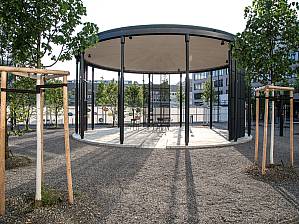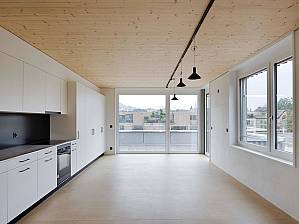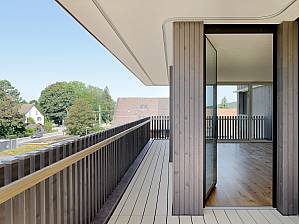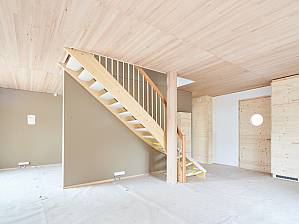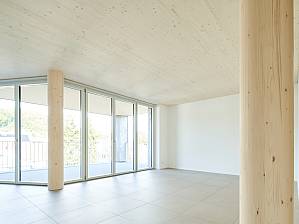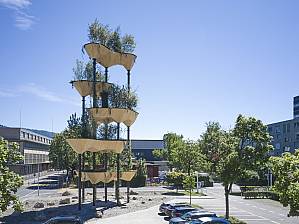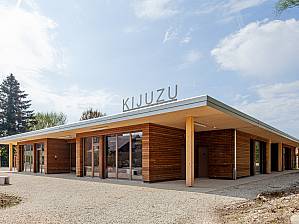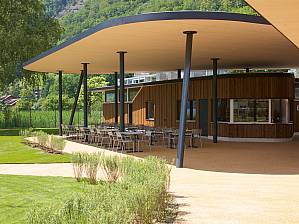TS3 receives approval in Germany: a milestone in 10 years of development
19. Mär 2024
A milestone has been reached! After a long development process, TS3 has received building authority approval and general type approval in Germany. Find out how this pioneering technology is taking timber construction into the next generation and what experiences over the last 10 years have led to this milestone.
A point-supported, biaxial load-bearing flat slab system in timber was the ambitious goal of the timber construction engineers at Timbatec. The idea arose from the desire to utilize the advantages of reinforced concrete structures in timber construction. After numerous project competitions in which classic reinforced concrete came out on top, intensive research and development work began to find a solution to this problem.
Can we think in concrete but build with wood?
The answer was a system solution that makes it possible to construct timber floor slabs with biaxial or planar load-bearing structures and only support them at certain points. From 2010, Timbatec worked together with leading research institutes such as Bern University of Applied Sciences and ETH Zurich and industrial partners on different variants for the lateral connection of cross-laminated timber panels. The development of such a revolutionary technology required enormous resources, which is why the company Timber Structures 3.0, or TS3 for short, was founded in 2014. The company came to the realization that a pure adhesive joint was sufficient to seriously compete with reinforced concrete structures. Several research projects were carried out with the support of the Swiss Forest and Wood Research Fund, Innosuisse and the Technology Fund to continuously deepen and improve performance. 8 Bachelor's theses, 15 Master's theses and 4 dissertations have provided insights into various adhesive systems, wood properties, processing parameters of the joining surfaces, production conditions, etc. Thousands of fracture stress values were generated in dozens of test series, mainly in tensile and bending tests. Long-term tests and construction site conditions (cold, moisture, solar radiation, movements, etc.) provided additional findings to enable the TS3 timber construction system to be used safely today.
After 6 long years with countless tests within the approval process at the German Institute for Building Technology (DIBt), TS3 has now reached another milestone! The general building authority approval (abZ) and the general type approval (aBG) have been completed and the TS3 technology can now also be used in Germany.
The approval for Germany is a significant step for TS3 and proof of the groundbreaking innovation we have developed in recent years. Stefan Zöllig, Founder TS3
The TS3 connection
TS3 technology enables the construction of solid timber ceilings with column spacings of up to eight by eight meters. The TS3 connection using joint grouting enables the construction of beam-free timber skeleton structures with slender, point-supported slabs, which was previously only possible in reinforced concrete. The design of a TS3 slab is similar to that of a reinforced concrete flat slab. The TS3 connection can be assumed to be rigid, which enables efficient modeling and calculation. Thanks to this technology, even irregular floor plans can be easily implemented, giving architects a high degree of creative freedom. This ground-breaking solution opens up completely new possibilities for timber construction and makes it possible to implement complex architecture that could previously only be realized with reinforced concrete.
Design of the TS3 joint
The TS3 joint is executed in two steps: Pre-treatment of the joint surfaces in the factory and casting of the TS3 joints on the construction site. After the cross-laminated timber ceiling elements have been joined, the joint surfaces are pre-treated in the joinery plant. The joint surfaces are sealed with the 2K-PUR "TS3 PTS PT192" and suitable filling tools. This pre-treatment fulfills several purposes at the same time. Firstly, it allows the casting resin to adhere to the face wood side under optimum factory conditions. Secondly, the fresh cut edge is preserved in its optimum condition for bonding. In addition, the joint surfaces are protected from external influences such as changes in humidity during transportation to the construction site. After pre-treatment and the application of sealing and segmentation tapes, the elements are packaged watertight for transportation. At the construction site, the panels are unpacked, visually inspected and lifted into the correct position by crane in accordance with the installation plan. The panels are placed on walls, supports or, if necessary, on falsework and, if necessary, supported with braces. The top of the TS3 joints is sealed with transparent adhesive tape. The 2C PUR casting resin is injected through the filling holes provided. This intelligent design principle ensures a high quality and secure joint, which is crucial to the success of TS3.
TS3 enables us to think in concrete but build with wood, opening up completely new possibilities for sustainable and innovative construction. Sven Bill, Managing Director TS3




